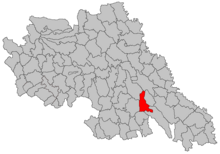Ciurea rail disaster

Location of Ciurea within present-day Iași County
|
|
| Date | 14 January [O.S. 1 January] 1917 |
|---|---|
| Time | 1 a.m. |
| Location |
Ciurea station 10 km (6.2 mi) S from Iași |
| Coordinates | 46°53′17″N 27°11′12″E / 46.88806°N 27.18667°ECoordinates: 46°53′17″N 27°11′12″E / 46.88806°N 27.18667°E |
| Country | Kingdom of Romania |
| Rail line | Bârlad–Iași |
| Operator | CFR |
| Type of incident | Derailment |
| Cause | Brake failure |
| Statistics | |
| Trains | 1 |
| Deaths | 800–1,000 |
Ciurea rail disaster, known in Romania as the Ciurea catastrophe (Romanian: Catastrofa de la Ciurea), occurred on 13 January 1917, during World War I, at Ciurea station, Iași County, a station with a passing loop, located on the railway line from Iași to Bârlad. Due to the absence of a formal investigation, the exact cause of the accident is not known, and the death toll is uncertain, with most sources indicating between 800 and 1,000 deaths. Thus, the Ciurea rail disaster is the third worst rail accident in world history, in terms of the number of victims.
Train E-1, nicknamed "the Courier", consisting of 26 cars, left Galați with destination Iași Friday, 11 January [O.S. 30 December 1916] 1917. It was running several hours late, because the station had been bombed by German airplanes, and its locomotive, hit by bombs, had to be replaced. Occupation of Brăila by Germans, who began to bomb Galați, caused the residents of nearby Muntenia to leave their town, in the belief that it was unsafe. They were joined by students and soldiers on leave. As well as Romanians, the train's passengers included Russian officers and soldiers, as well as members of the French military mission. Among the best-known travelers were Emil Costinescu, former Minister of Finance, Yvonne Blondel, daughter of a former French ambassador to Bucharest, geographer George Vâlsan and marquis de Belloy (French official). Very soon, the train became overcrowded. More cars were added as the train proceeded along its route, with the train sometimes waiting for hours as hundreds of travelers tried to make room.
Travel conditions were terrible: the wagons, many of them boxcars, illuminated by gas lamps, were cold; the windows had no glass, but planks that failed to keep out the frigid air. On the roofs of the wagons, travelers died of cold. "To our horror, a man and a 10-year-old boy were taken down frozen. Other shadows that were staggering, hardened by cold, recounted that, at some curves, many people – men and women – had been thrown off the train", writes Yvonne Blondel.
...
Wikipedia
